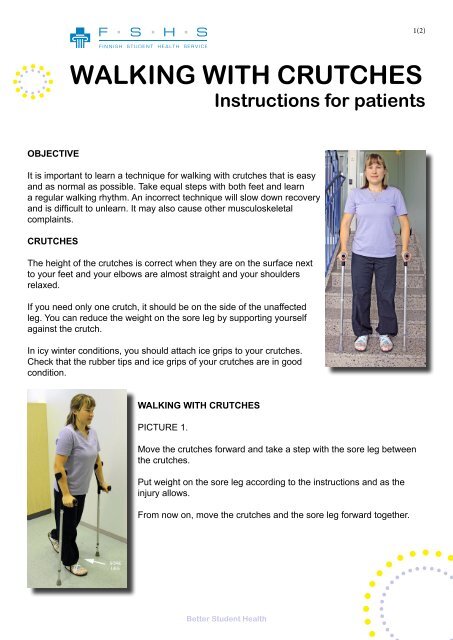Walking with crutches, Instructions for patients - YTHS
Walking with crutches, Instructions for patients - YTHS
Walking with crutches, Instructions for patients - YTHS
Create successful ePaper yourself
Turn your PDF publications into a flip-book with our unique Google optimized e-Paper software.
1(2)WALKING WITH CRUTCHES<strong>Instructions</strong> <strong>for</strong> <strong>patients</strong>OBJECTIVEIt is important to learn a technique <strong>for</strong> walking <strong>with</strong> <strong>crutches</strong> that is easyand as normal as possible. Take equal steps <strong>with</strong> both feet and learna regular walking rhythm. An incorrect technique will slow down recoveryand is difficult to unlearn. It may also cause other musculoskeletalcomplaints.CRUTCHESThe height of the <strong>crutches</strong> is correct when they are on the surface nextto your feet and your elbows are almost straight and your shouldersrelaxed.If you need only one crutch, it should be on the side of the unaffectedleg. You can reduce the weight on the sore leg by supporting yourselfagainst the crutch.In icy winter conditions, you should attach ice grips to your <strong>crutches</strong>.Check that the rubber tips and ice grips of your <strong>crutches</strong> are in goodcondition.WALKING WITH CRUTCHESPICTURE 1.Move the <strong>crutches</strong> <strong>for</strong>ward and take a step <strong>with</strong> the sore leg betweenthe <strong>crutches</strong>.Put weight on the sore leg according to the instructions and as theinjury allows.From now on, move the <strong>crutches</strong> and the sore leg <strong>for</strong>ward together.Better Student Health
PICTURE 2.2(2)Take a step by moving the unaffected leg past the sore leg.Return to a normal walking rhythm as soon as possible: take equalsteps <strong>with</strong> both legs and avoid limping and “hopping”.PICTURE 3.<strong>Walking</strong> up stairs:Keep your weight on the <strong>crutches</strong> and putthe permitted amount of weight on the soreleg. Place the unaffected leg on the higherstep and step up. Move the <strong>crutches</strong> andthe sore leg next to the unaffected leg.Move up one stair at a time.PICTURE 4.<strong>Walking</strong> down stairs:Keep your weight on the unaffected leg.Place the <strong>crutches</strong> and the sore leg on thelower step. Move the unaffected leg nextto the sore leg. Move down one stair ata time.WEIGHT-BEARINGRemember to ask the person treating you how much weight you canput on the sore leg. Only in exceptional cases will you be instructednot to put any weight on the sore leg. In most cases, weight can beput on the sore leg as permitted by pain. Even after a fracture, you willgenerally be permitted to allow the affected leg to take its own weight(about 15 kg). If possible, check how much weight you are putting onthe leg using bathroom scales.As you recover, you should put more weight on the affected leg andstart using just one crutch, taking care not to limp. This will improveyour recovery and help you return to normal walking. The ability towalk faster and run will come later.www.yths.fi/en<strong>Instructions</strong> by:physiotherapist Seija SalmikiviPictures:Hannele Salminen2013









